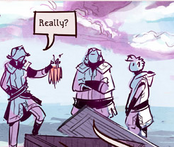
Various edible items are shown throughout the comic. This can be used to speculate on the state of food production and availability in The Known World.
The most significant change occurring post-rash is the inability to import products from warmer climates, as was common in the Nordic countries before The Rash. The cold climate also makes it difficult to grow many foods that Year 0 populations were used to, such as tropical fruits and coffee.
Availability and Resources
Produce

The production of fruit seems to have taken a hit, as Siv likens fruit juice to "liquid gold" when the Quartet visits Reykjavík. For vegetables, the situation seems to be better, as shown both by the potatoes Reynir peeled aboard the Túnfiskurinn and the carrots its crew passed on to the protagonists.
Grain products
Large parts of settlements in Keuruu and Bornholm appear to be set aside for farming purposes, and grains appear to be readily available. The train to Mora features a dining cart with porridge and sandwiches. Mikkel later offers a cookie or cracker of some sort to Lalli.
More extravagant baked goods are also seen. Trond's retirement party featured a layered cake, and in the Book 1 Extra comic, Tuuri visits a bakery in Mora which stocks many colorful cakes and pastries in addition to ordinary breads. She reveals that sugar is difficult to obtain in Finland. Possible post-rash sources of sugar include honey and sugar beets, though we're not sure to which extent either is used.
Beverages

Both tea and coffee are not grown in the Scandinavian countries and were imported in great quantities in Pre-Rash times. It is possible that some herbal teas have been developed using native plants and herbs. Sigrun is shown drinking some type of hot beverage when the crew has breakfast together upon reaching Kastrup, though we do not see what it is.
In a flashback to Dalsnes, we see wooden goblets similar to those which are commonly used to serve wine and other alcoholic beverages, so it seems likely that distilling processes are still being used.
Meat and Fish
We see various kinds of meat dishes portrayed, such as meatballs, sliced cold-cuts, and whole fish, presumably grilled or cured. In terms of livestock animals, there have been mentions of sheep and pigs, and visual evidence of cows and horses. Information on what and how much is provided by the (non-grossling) hunters is not yet available.
The traditional kinds of meat sources of Iceland are fish and sheep, the latter being more of a staple in Icelands own food than the former. In spite of Iceland's isolation in early post-Rash times, these habits seem to have been revived; the Túnfiskurinn is shown transporting canned tuna to Bornholm, while sheep - like the ones Reynir herded on his parents' farm - did not become apparent in its cargo.
Lalli is seen dropping a squirrel into the team's stew on arc 1 page 534![]() . The fact that it appears not to have been skinned confirms that he is indeed not officially a hunter, and might not have received any training for that job.
. The fact that it appears not to have been skinned confirms that he is indeed not officially a hunter, and might not have received any training for that job.
Traditional Nordic Dishes
Finland

Lalli eating an older (thus drier and harder) reikäleipä
Starting on arc 1 page 388![]() , we see the central canteen handing out pea soup and (ruis)reikäleipä (rye bread in a flat donut shape, to have it threaded onto poles then hung below the ceiling). This dish is so typical for canteen kitchens of pre-Rash Finland (and Sweden) that commenters claimed the scene "must have happened on a Thursday"; using up remaining meat and providing a rather long-lasting sustenance made pea soup the ideal dish on the day before the Catholic "no meat" Friday.
, we see the central canteen handing out pea soup and (ruis)reikäleipä (rye bread in a flat donut shape, to have it threaded onto poles then hung below the ceiling). This dish is so typical for canteen kitchens of pre-Rash Finland (and Sweden) that commenters claimed the scene "must have happened on a Thursday"; using up remaining meat and providing a rather long-lasting sustenance made pea soup the ideal dish on the day before the Catholic "no meat" Friday.
Sweden
The dish that another traveler spills on Emil![]() looks like it has meatballs on top. The traditional Swedish köttbullar recipe would have them complemented with potatoes, gravy, and lingonberry jam. The dish that the smell subsequently makes Emil dream of, however, looks rather like the meatballs are sitting atop a bowl of spaghetti - a combination that is actually not Italian but Italian-American.
looks like it has meatballs on top. The traditional Swedish köttbullar recipe would have them complemented with potatoes, gravy, and lingonberry jam. The dish that the smell subsequently makes Emil dream of, however, looks rather like the meatballs are sitting atop a bowl of spaghetti - a combination that is actually not Italian but Italian-American.
